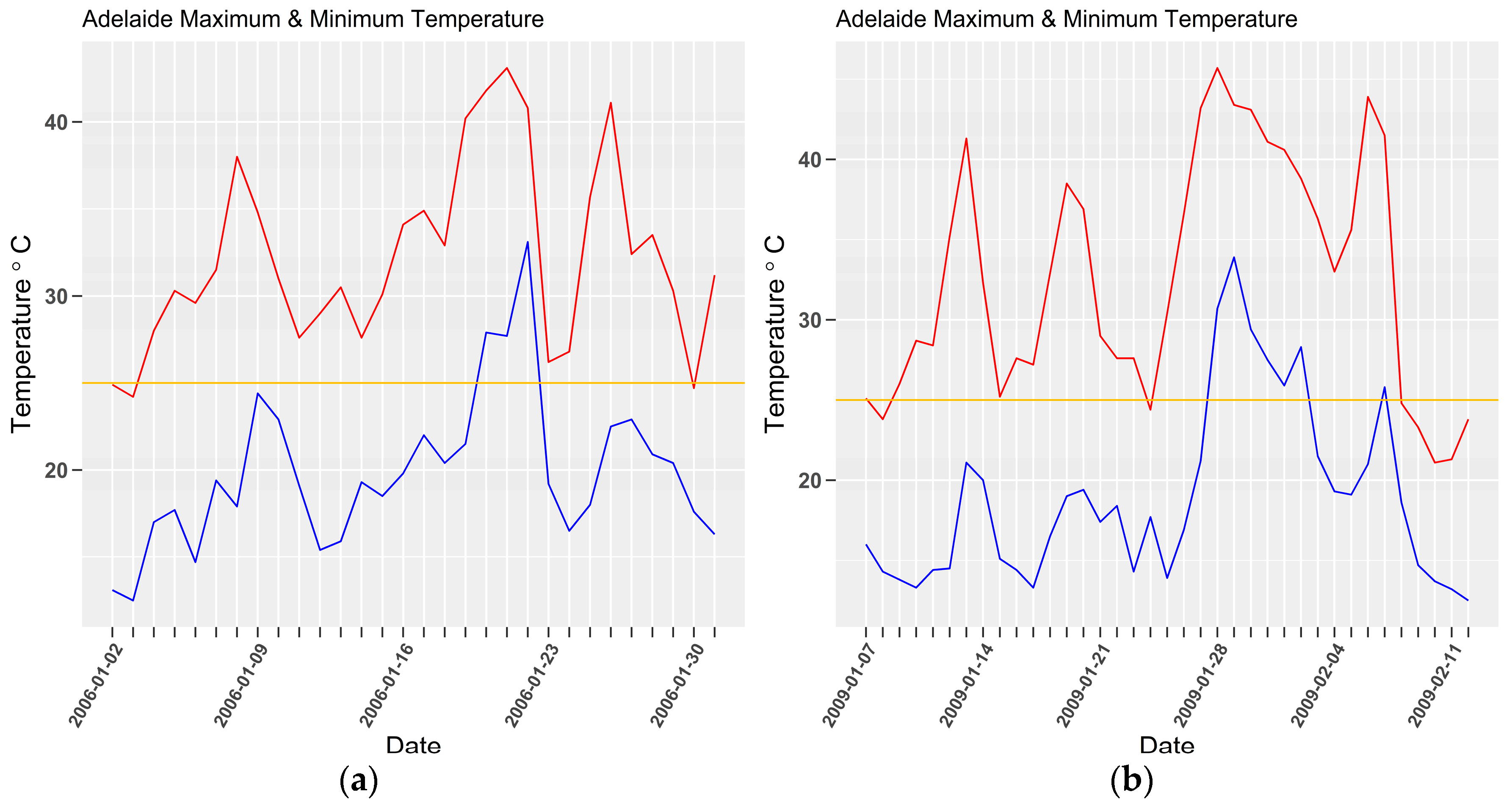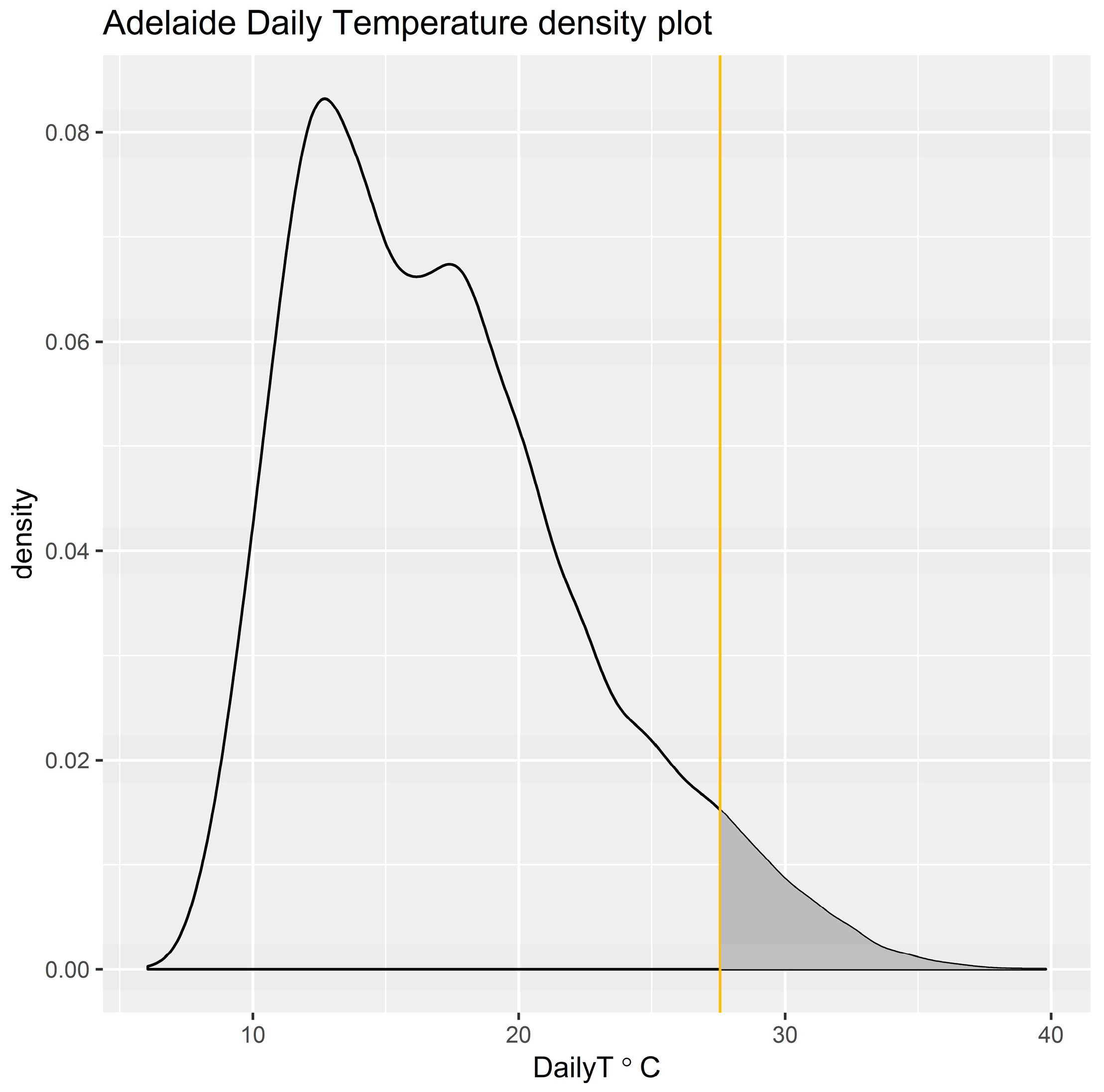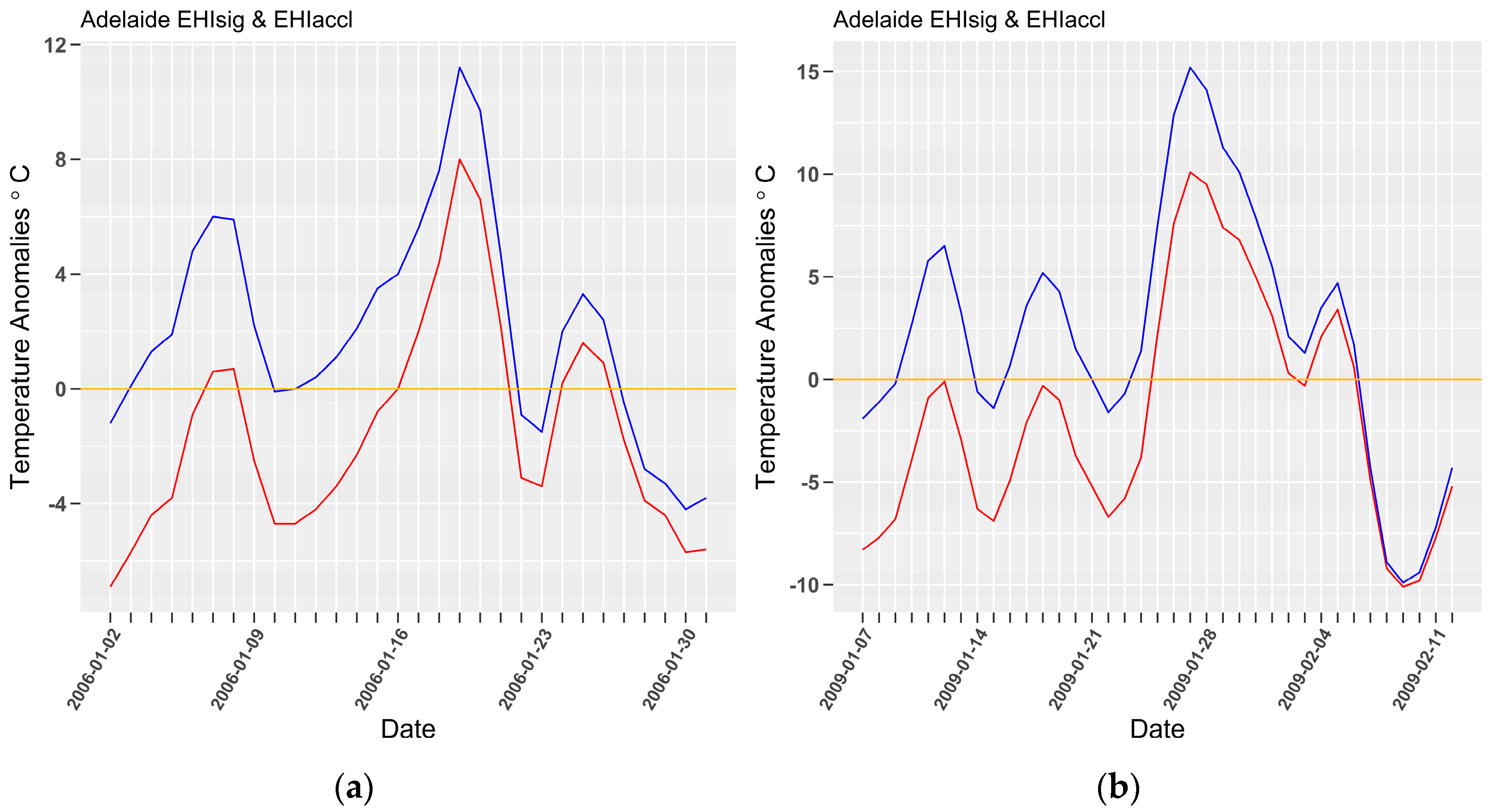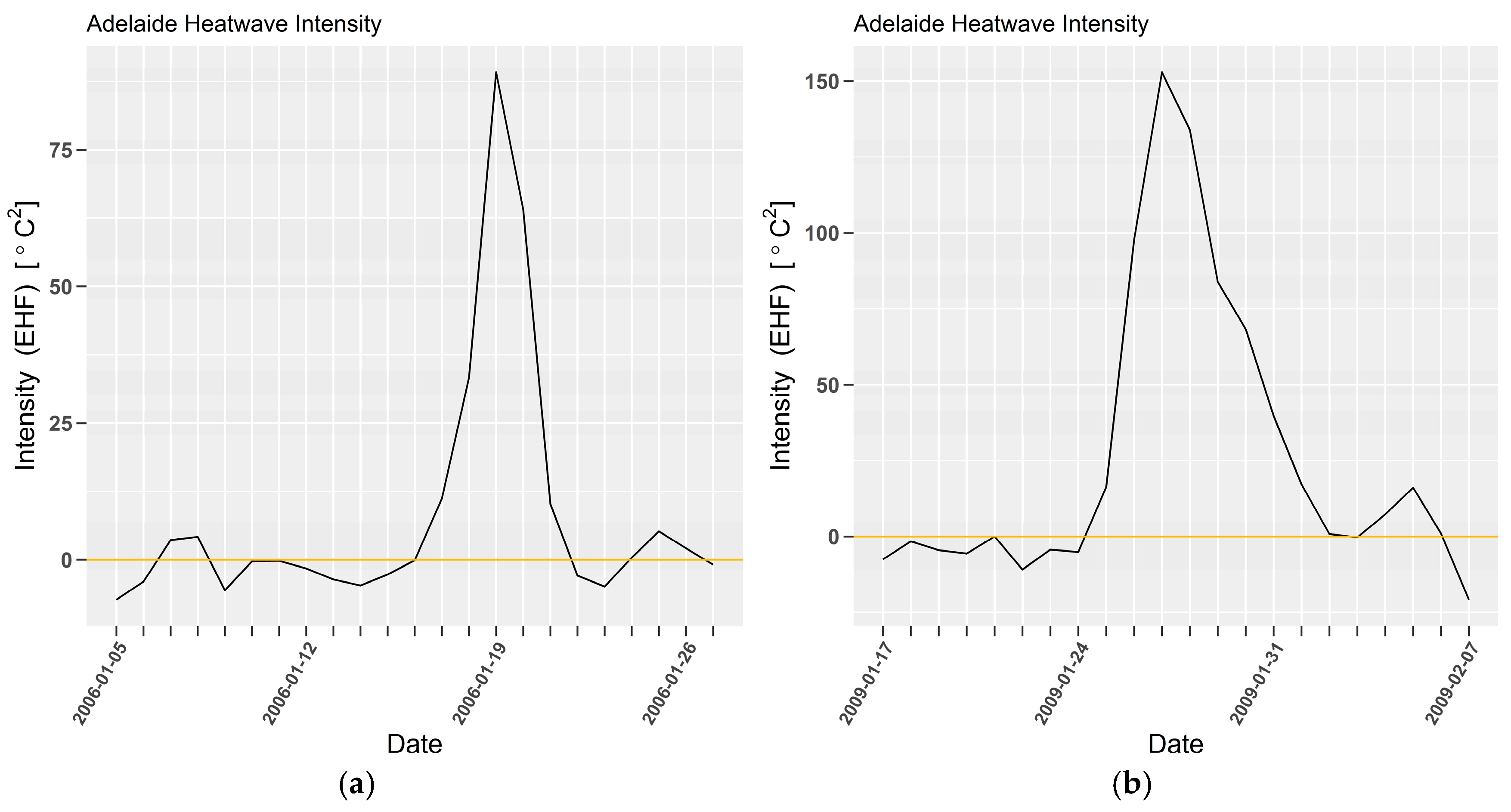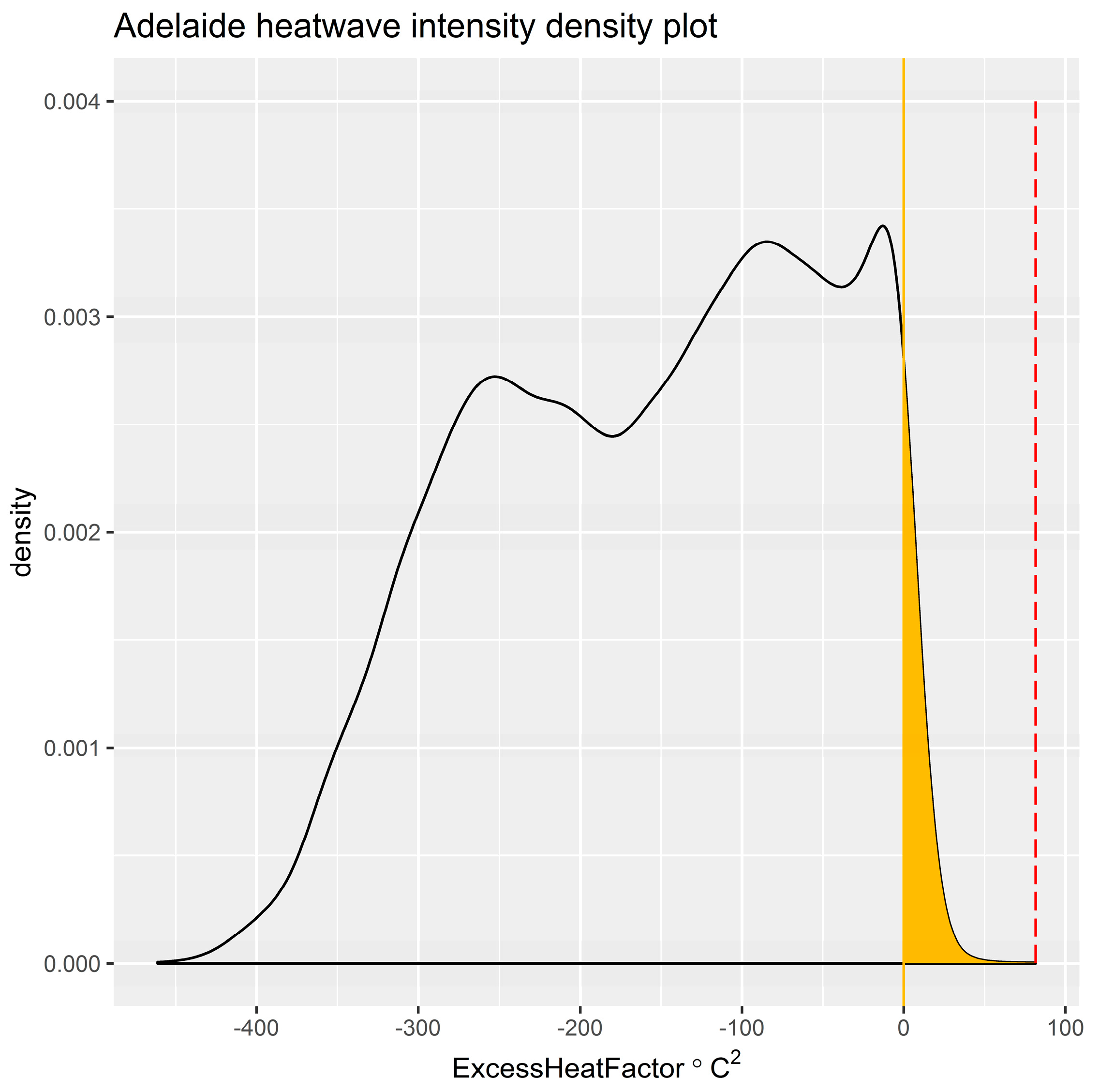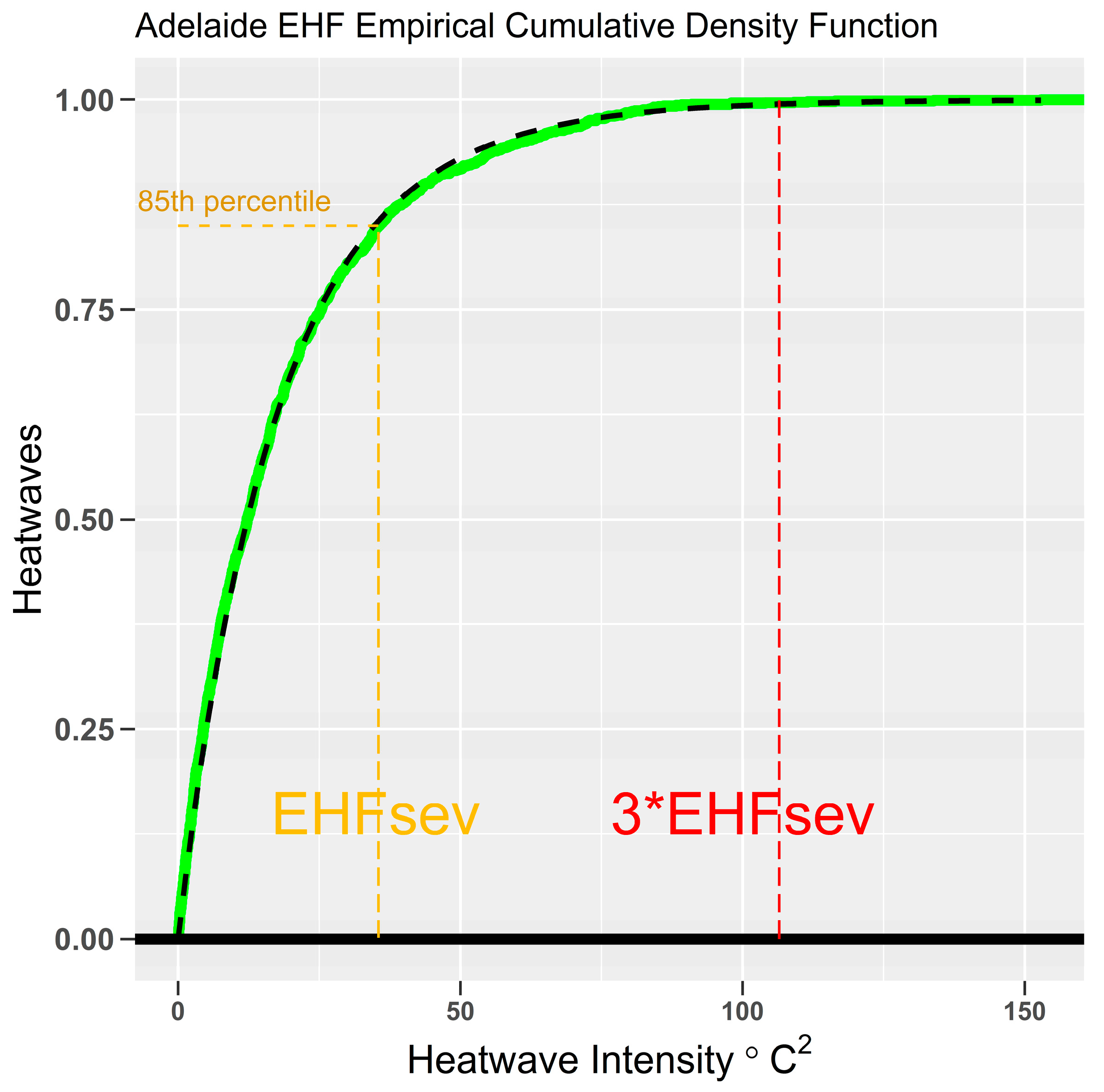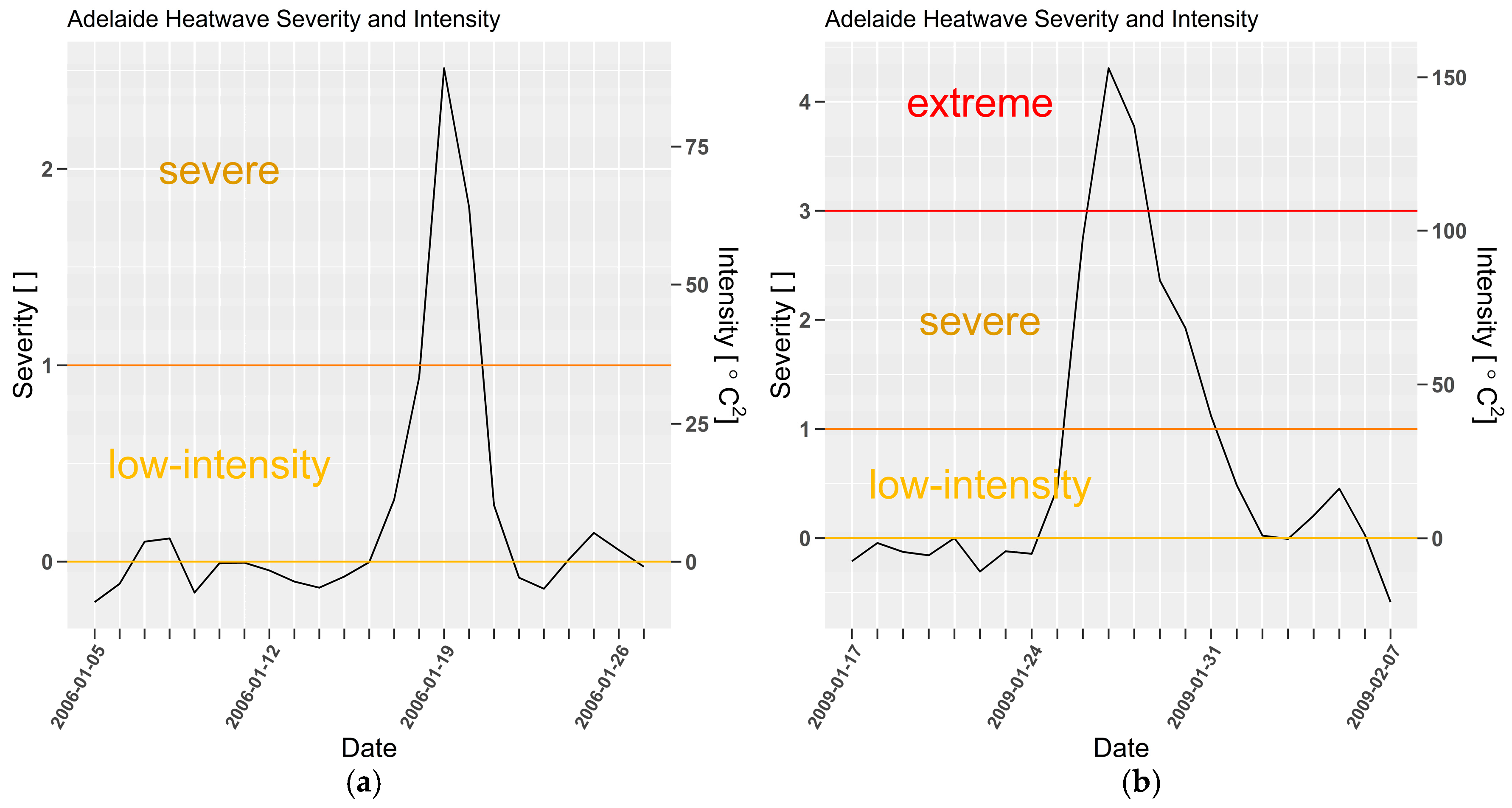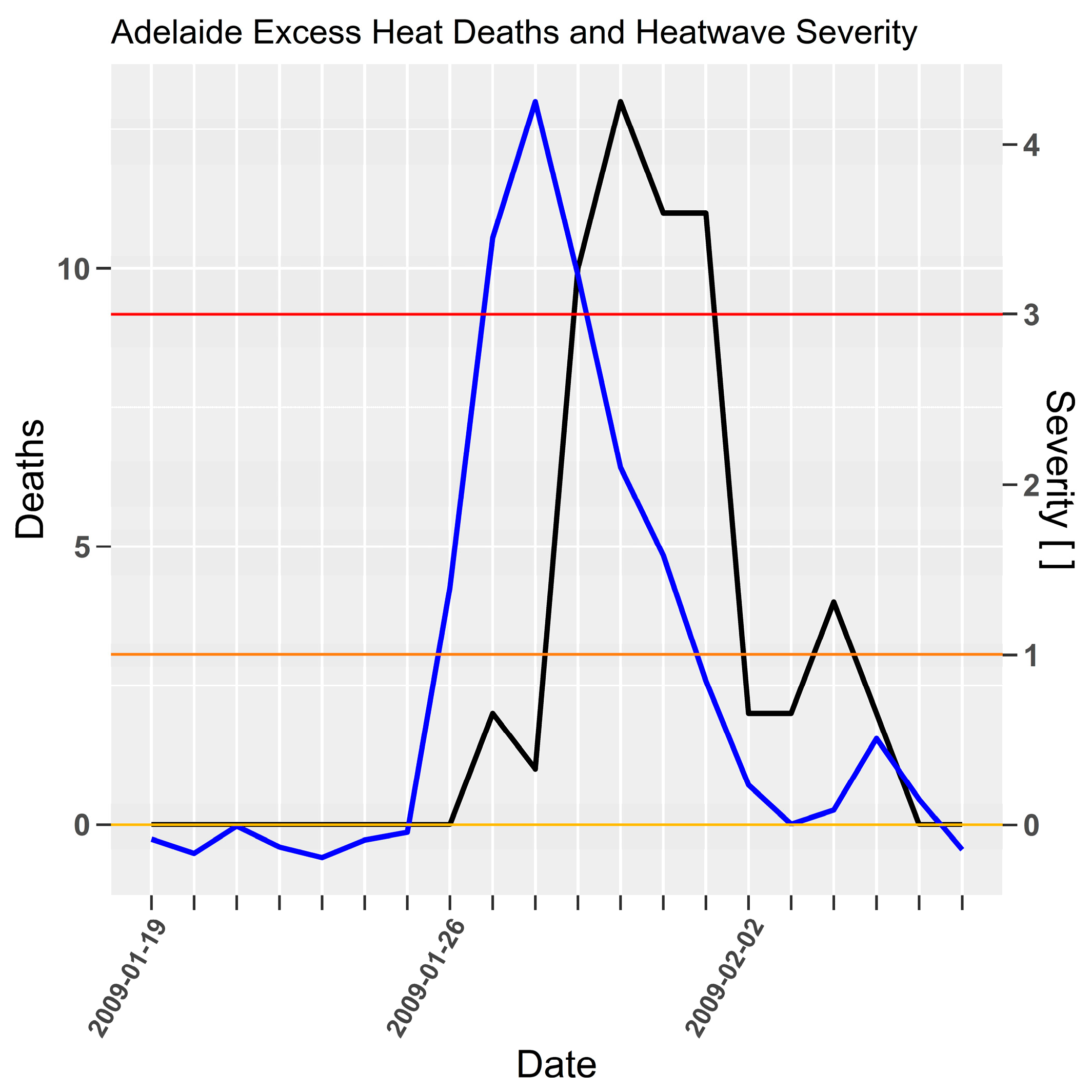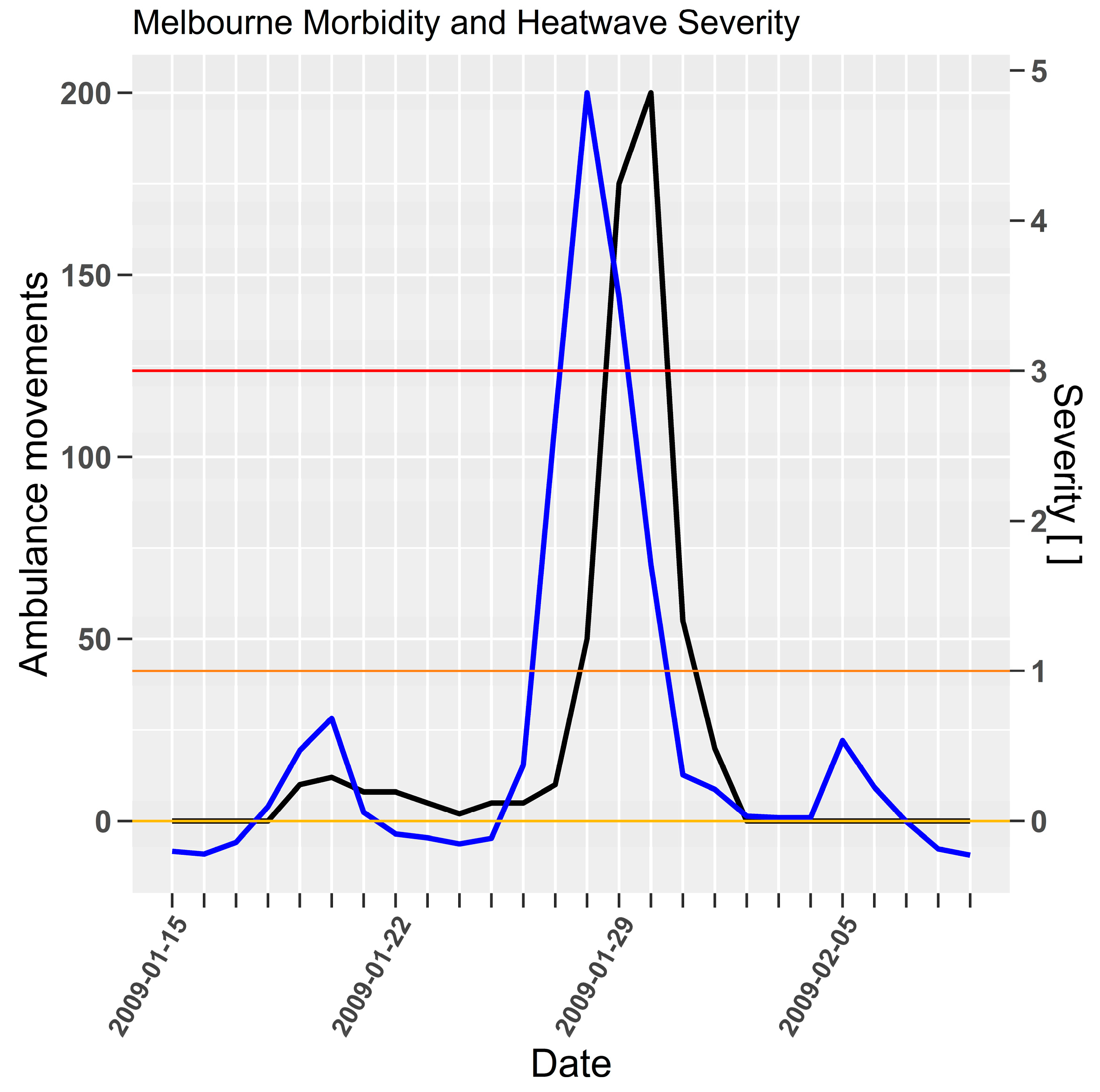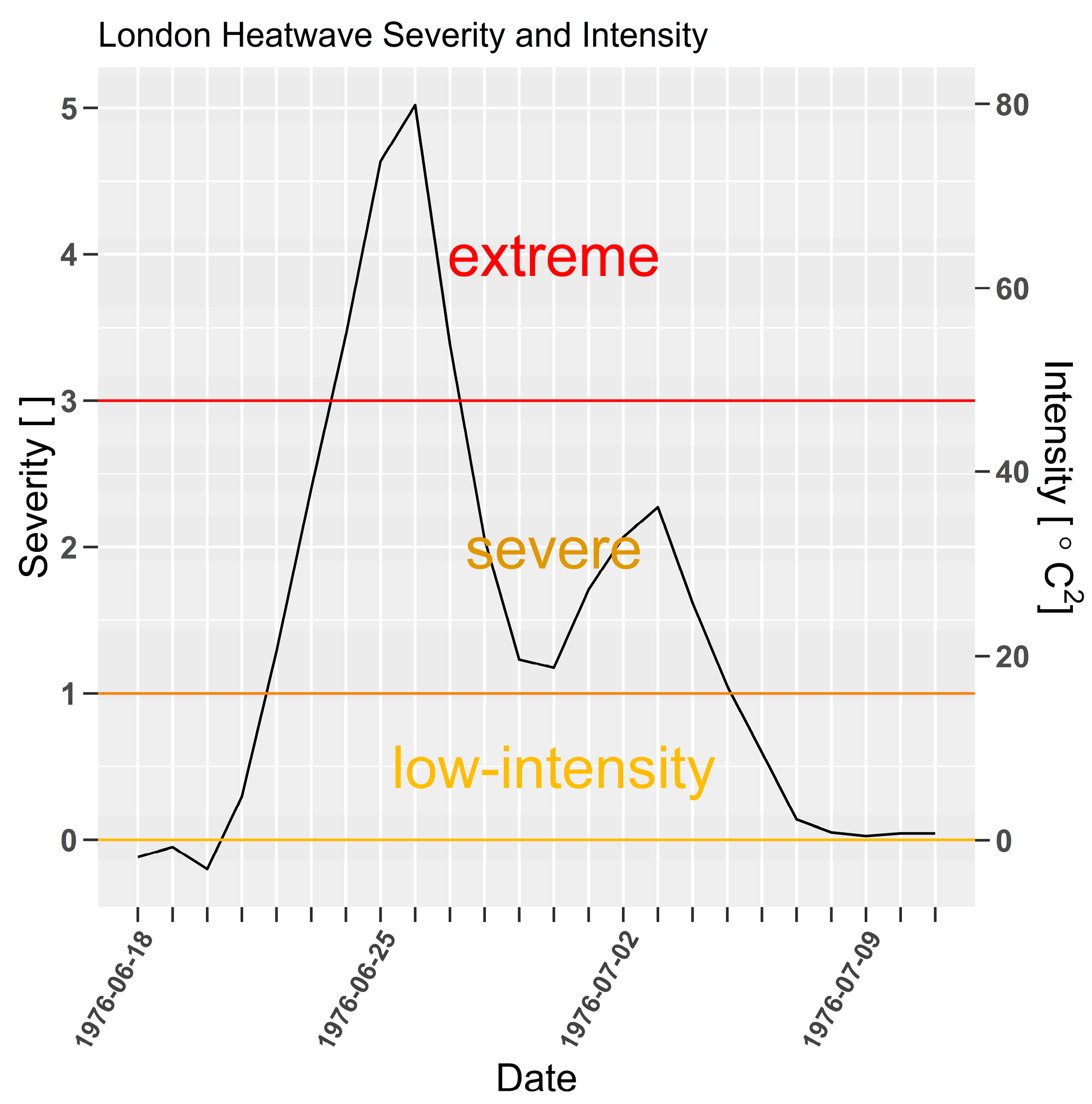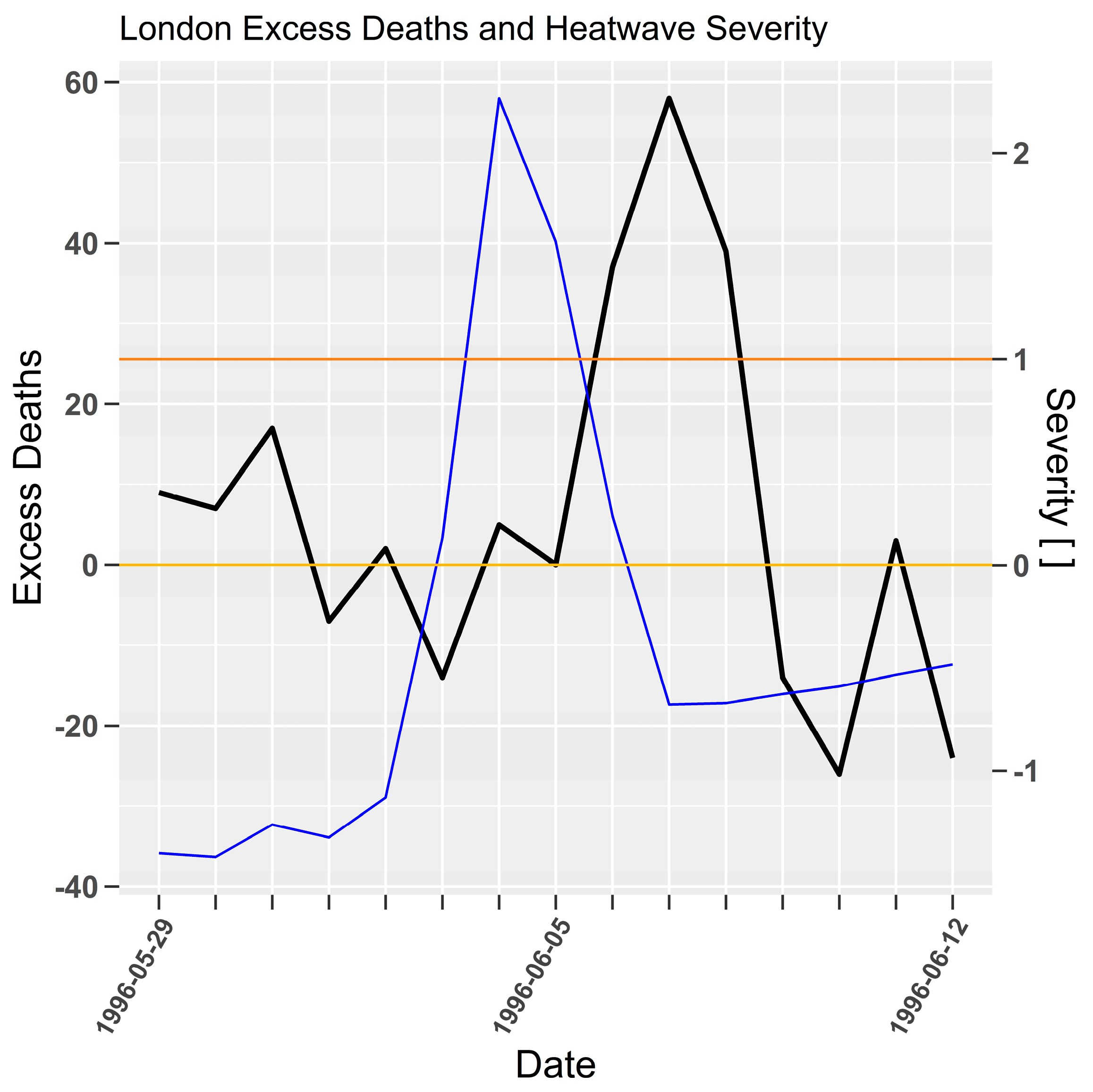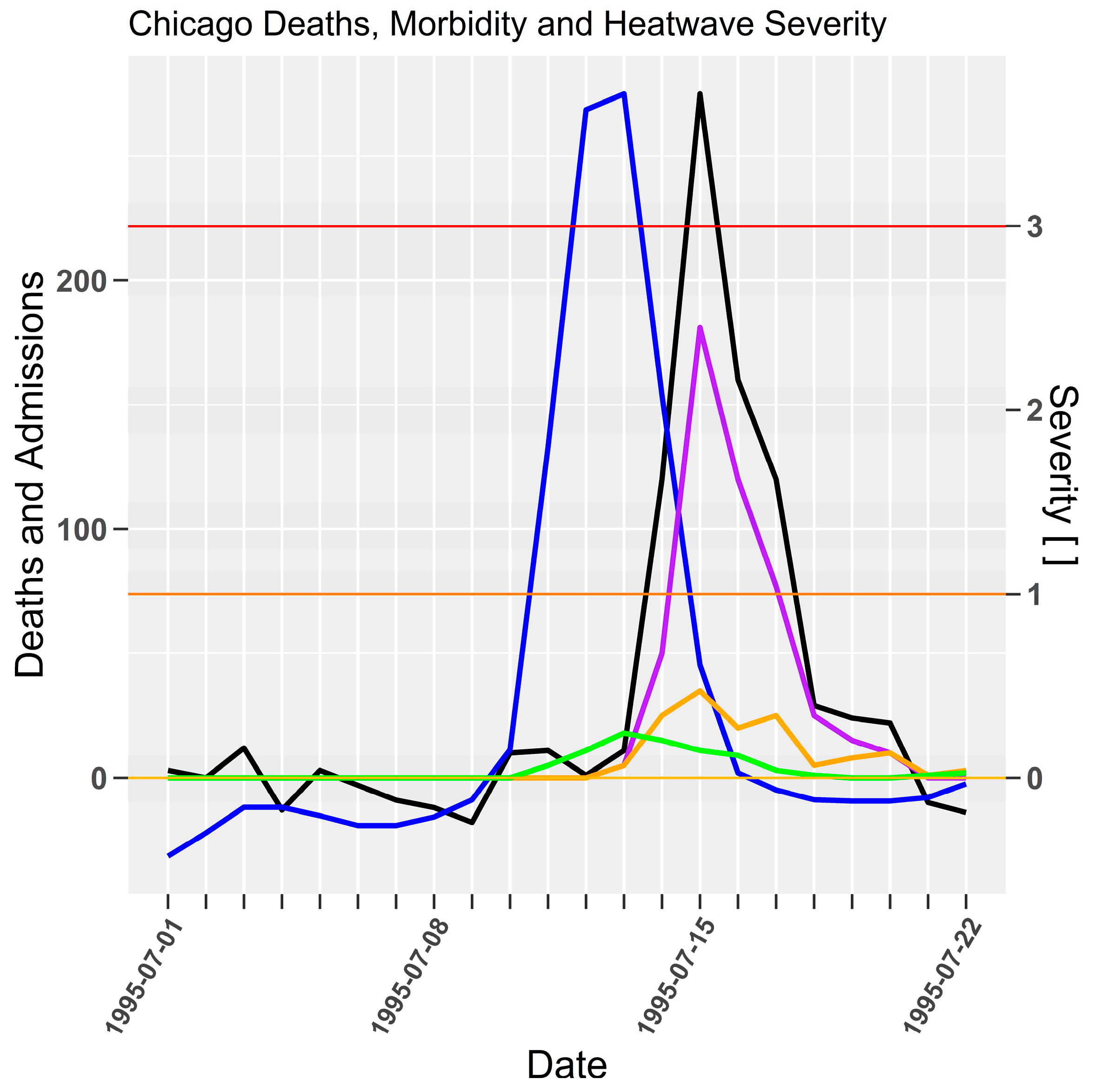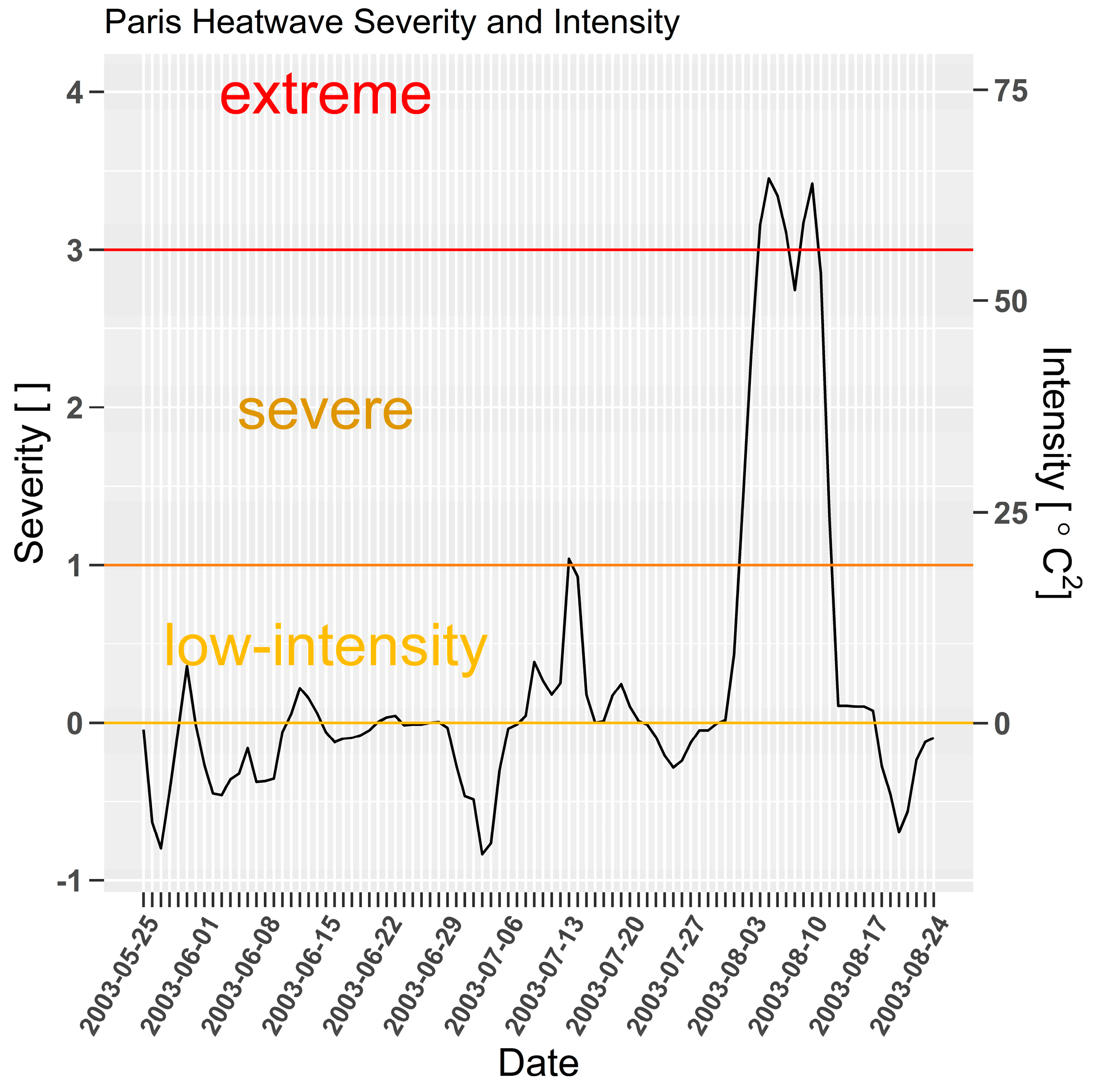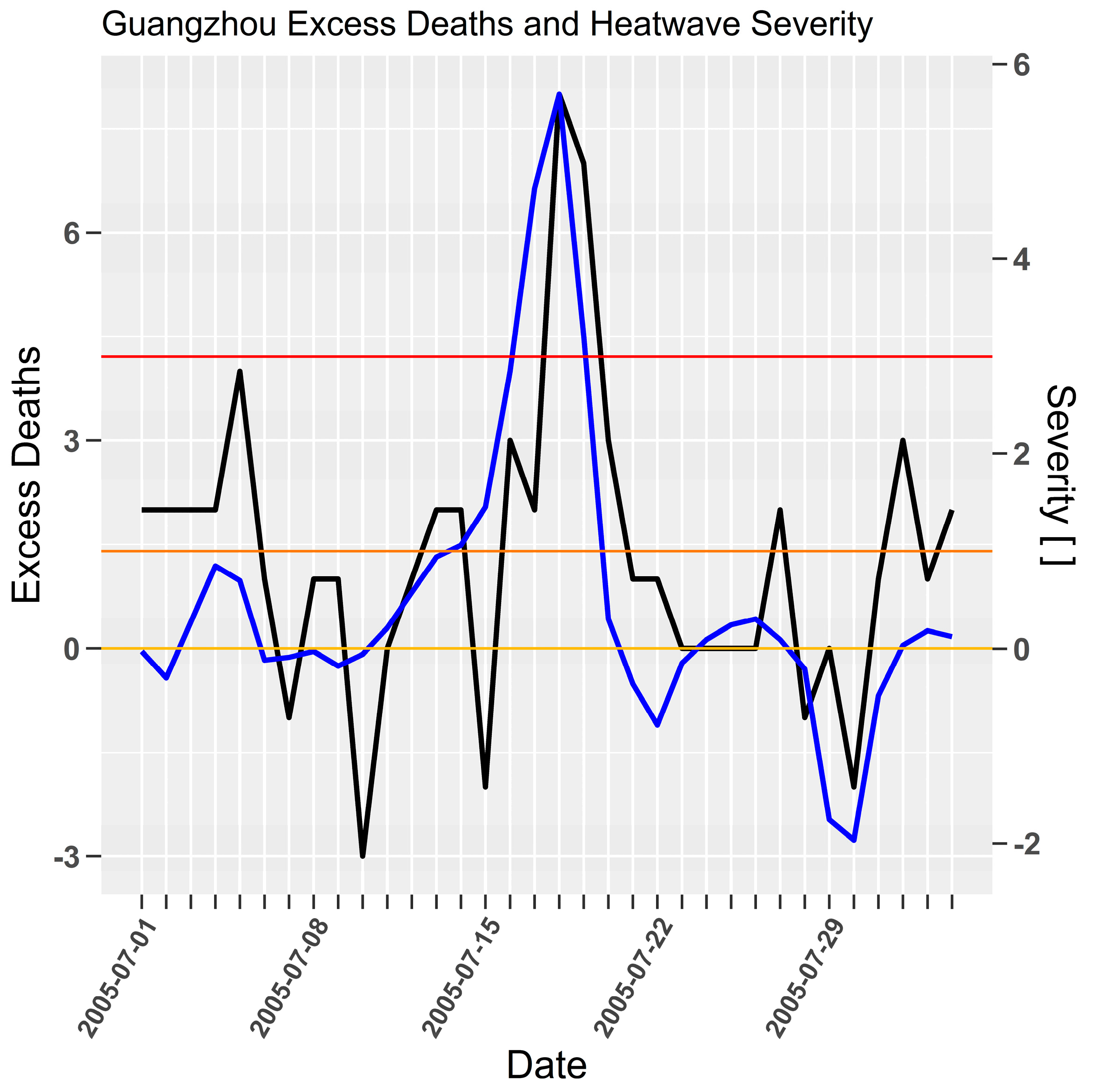Appendix A.1. Heatwave Intensity
The excess heat factor (
EHF) [
18] has been developed as a measure of heatwave intensity. The formulation of
EHF is a factorization of two excess daily heat indices which measure:
These long and short-term temperature anomalies are described as the Excess Heat Index
EHIsig for a significant heat event and the Excess Heat Index
EHIaccl for a heat event requiring an adaption or acclimatization response. These anomalies are estimated as
with
DMT3-day denoting the average daily temperature of the next (or t, t + 1, t + 2) 3 day period,
DMT95 the percentile of daily temperatures for the 30 year reference period between 1971–2000, and
DMT30-day the average daily temperature of the previous 30 day period, respectively.
During a heatwave, minimum temperature significantly affects the diurnal cycle of heating. High minimum temperature will result in earlier and longer sustained high temperatures with stronger heat accumulation within the diurnal heating cycle. Consequently, the average of maximum and minimum temperatures over three days, or daily mean temperature (DMT), is used in these heat anomaly calculations.
Minimum and maximum temperatures are displayed in
Figure A1a,b, for Adelaide heatwaves in 2006 and 2009, demonstrates the rational for using
DMT. A reference temperature of 25 °C in these figures demonstrates the different capacity for heat to be discharged overnight. By the 8th and 9th of January 2006 the minimum has risen close to 25 °C whilst the maximums are much higher in the high 30’s. There is little capacity for the heat of the day to be discharged at night with a high minimum temperature. Consequently, this heat is accumulated with an additional heat impost the following day. Heat will not be accumulated whilst the area between the red and yellow lines (maximum temperatures and 25 °C) is balanced by the area below the yellow to the blue line (25 °C and minimum temperatures). Excess is clearly a problem by 20 January once the minimum temperature has risen above 25 °C, where there is no capacity to discharge heat.
In 2009 daily accumulations of heat are being discharged until late January, when suddenly much higher maximum and minimum temperatures commence at the same time. The much higher maximum and minimum temperatures resulted in greater excess heat producing a more intense heatwave.
The use of daily temperature (average of maximum and minimum temperatures) accommodates the concept of heat discharge.
Figure A1.
Daily maximum and minimum temperatures for Adelaide heatwaves in 2006 (a) and 2009 (b). 25 °C reference temperature (yellow line).
Figure A1.
Daily maximum and minimum temperatures for Adelaide heatwaves in 2006 (a) and 2009 (b). 25 °C reference temperature (yellow line).
Reference periods used for calculating Adelaide’s excess temperature anomalies are presented in
Figure A2 and
Figure A3. The climatological distribution of daily temperature (
DMT) for the period 1971 to 2000 is shown in
Figure A2, which illustrates the positive tail in the distribution representing all heatwave events.
Figure A2.
Distribution function of daily temperature for all days in 1971 to 2000 climate reference period. Grey shade shows 95th percentile tail for all heatwaves present for this reference period.
Figure A2.
Distribution function of daily temperature for all days in 1971 to 2000 climate reference period. Grey shade shows 95th percentile tail for all heatwaves present for this reference period.
Unlike the single-day, daily temperature reference period shown above, the 30-day reference period for the short-term temperature anomaly is highly subjective to the weather events occurring over that period. The climatological distribution of the acclimatization heat index utilizes 30-day running mean daily temperatures is shown in
Figure A3 illustrates the sample population for the multi-week, weather determined short-term heat anomaly.
Figure A3.
Distribution function of EHIaccl for 1960 to 2018 climate period. Shaded region >1 shows acclimatization distribution samples when calculating EHF.
Figure A3.
Distribution function of EHIaccl for 1960 to 2018 climate period. Shaded region >1 shows acclimatization distribution samples when calculating EHF.
Calculation of heatwave intensity (
EHF) is designed to treat the acclimatization index as an amplifying factor which does not reduce the significance of climate threshold excess heat;
The shaded region in
Figure A3 shows the distribution of warm acclimatization events that are >1. Only a sub-sample of this population subset is related to heatwaves, noting that positive 30-day anomalies can occur at any time during the year.
Adelaide heatwave examples are shown in
Figure A4a,b, demonstrating the evolution of the
EHIsig and
EHIaccl indices in 2006 and 2009.
The long and short-term temperature anomalies in 2006 show three heatwave events. EHIsig became positive for a short period in early January, with a more significant positive anomaly in both EHIsig and EHIaccl lasting for a longer period. Finally, a smaller event, more significant than the first developed briefing after the major heatwave.
Figure A4.
Acclimatization (blue) and significance (red) Excess Heat Indices for Adelaide’s 2006 (a) and 2009 (b) heatwaves, calculated using site data.
Figure A4.
Acclimatization (blue) and significance (red) Excess Heat Indices for Adelaide’s 2006 (a) and 2009 (b) heatwaves, calculated using site data.
On two occasions during the first half of January 2009 EHIsig nearly became positive, so not heatwaves. This was followed by very large long and short-term temperature anomalies (up to 10 °C larger than those observed in 2006) resulting in an extreme heatwave that lasted for two weeks.
The same Adelaide heatwaves are shown again in
Figure A5a,b, showing heatwave intensity (Excess Heat Factor).
In 2006 the intensity of the early heatwave is quite small compared to the event in the second half of January. The peak
EHF value of 67 °C
2 is the combination of the peak
EHI values shown in
Figure A4a. When multiplied, large
EHIsig and
EHIaccl values will produce very large
EHF values, indicating a very intense heatwave. Conversely, smaller
EHIs will produce much smaller
EHF values, indicative of low-intensity heatwaves.
The third 2006 heatwave shown in
Figure A5a is of similar intensity to the first event in early January, despite the higher temperature anomalies observed in
Figure A1a. This is a consequence of reduced acclimatization due to the immediately preceding intense heatwave, which can be seen in
Figure A4a. It is notable that the context in which the high temperature event occurs will determine the intensity of the heatwave. The early January heatwave had low
EHIsig but higher
EHIaccl.
Figure A1a shows the lower maximum and minimum temperatures at the start of the month which contributed to the higher short-term temperature anomaly once the heatwave started. The factored
EHIs for the third event produced the same heatwave intensity, despite the higher temperatures observed. Acclimatization (or adaptation) can either amplify or dampen the derived heatwave intensity.
In 2009 an extremely intense heatwave is shown in
Figure A5a. In
Figure A1b lower maximum and minimum temperatures abruptly shift into much higher values. This is evident in
Figure A4b where
EHIsig and
EHIaccl both change abruptly. The large change in acclimatization due to the much milder preceding conditions has resulted in significant amplification of the heatwave intensity signal. As seen in the 2006 example, the multiplication of two larger indices has resulted in a significant intensity signal.
EHF measures heatwave intensity, sensitive to the recent past (acclimatization/adaptation) and the local climate. EHF is location specific. The 95th percentile of daily temperature for the 1971 to 2000 climate reference period is specific to each location, and cannot be related to any other location’s climate. This is an obstacle to comparing heatwave intensity values between locations.
Figure A5.
Excess Heat Factor for Adelaide’s 2006 (a) and 2009 (b) heatwaves, calculated using site data.
Figure A5.
Excess Heat Factor for Adelaide’s 2006 (a) and 2009 (b) heatwaves, calculated using site data.
Appendix A.2. Heatwave Severity
The strong signal to noise provided by factoring two temperature anomalies provides another heatwave measurement opportunity. As a quadratic calculation [°C
2], positive
EHF obeys a power law. The population of
EHF shown in
Figure 6A, shows the distribution of positive and negative
EHF values. Only
EHF values > 0 (shown in yellow) are heatwaves. The power law attributes of positive
EHF are exhibited by the heavy tail distribution (shaded yellow) of heatwaves in this figure.
Figure A6.
Distribution function of EHF for period 1887 to 2018. Values greater than zero shown in yellow are heatwaves. Maximum EHF value in distribution is indicated by dashed red line.
Figure A6.
Distribution function of EHF for period 1887 to 2018. Values greater than zero shown in yellow are heatwaves. Maximum EHF value in distribution is indicated by dashed red line.
A strategy to normalize heatwave intensity has been employed, allowing direct comparison of heatwave severity, irrespective of event location.
Following Nairn and Fawcett [
18], the cumulative density function of positive
EHF (
Figure A7) was demonstrated to exhibit the characteristics of a Generalized Pareto Distribution function which is suited to power function (heavy tail) distributions. It is useful to observe how the heatwave intensity (
EHF) distribution changes in
Figure A7. Low-intensity heatwaves constitute most of the heatwaves observed. In
Figure A7 the 85th percentile has been highlighted with a dashed yellow line. Most, (85%) of all heatwaves are low-intensity. For the latter part of the distribution heatwave intensity rapidly becomes more intense. The transition from frequently observed, low-intensity to increasingly rare and more intense heatwaves has been identified as a transition point for population adaptation limits.
Figure A7.
Adelaide empirical cumulative distribution of positive EHF (green line), overlain with the modelled generalized Pareto distribution (black dashes), and showing the 85th percentile (transition point) for determining the severe EHF threshold (dashed yellow lines). Extreme EHF threshold is shown in red (dashed red lines).
Figure A7.
Adelaide empirical cumulative distribution of positive EHF (green line), overlain with the modelled generalized Pareto distribution (black dashes), and showing the 85th percentile (transition point) for determining the severe EHF threshold (dashed yellow lines). Extreme EHF threshold is shown in red (dashed red lines).
We appealed to the usefulness of the Pareto Principle [
45] when considering the proximity of this transition point to the 80th percentile of the distribution function. Juran [
46] observed the “vital few and trivial many”, a principle that approximately 20 percent of something are responsible for 80 percent of the results, which became known as Pareto’s Principle or the 80/20 Rule. In this application, the 85th percentile was selected as a threshold for heatwave severity as a transition point between low-intensity and severe heatwaves. Note the near perfect correspondence between empirical and modelled cumulative density in
Figure A7.
A climatological record of heatwave intensity (30 years or greater) provides a stable 85th percentile
EHF value (
EHF85) which can then be used to normalize heatwave intensity into what has been called heatwave severity categories. A severity quantity of 1 at any location can be interpreted as the last 15% of the cumulative distribution heatwave days.
Each location has a distribution of heatwave intensity that is determined by the climatological temperature range, which in turn is characterized by its own unique value of
EHF85. For Adelaide, these dimensionless severity categories have been shown in
Figure A8a,b, reaching category 2 in 2006 and over 4 in 2009.
Comparing heatwave intensity at a location can be achieved through analysis of heatwave intensity or severity. However, heatwaves can only be compared between locations by utilizing dimensionless severity categories.
Figure A8.
Excess Heat Factor for Adelaide’s 2006 (a) and 2009 (b) heatwaves, calculated using site data. Dimensionless heatwave severity [ ] and intensity (EHF, [°C2]) on left and right y-axes respectively.
Figure A8.
Excess Heat Factor for Adelaide’s 2006 (a) and 2009 (b) heatwaves, calculated using site data. Dimensionless heatwave severity [ ] and intensity (EHF, [°C2]) on left and right y-axes respectively.
Appendix A.3. Summary
Daily temperature has been adopted as a means of calculating heat accumulation. High minimum temperature adjusts the rate at which high temperatures are achieved in the following diurnal cycle, and restrict the capacity for heat discharge from the previous heating cycle. In this context minimum temperature is more important than the maximum temperature in the estimation of heat accumulation.
Minimum temperature is also affected in the presence of a humid atmosphere. Water vapor is a very strong greenhouse gas, restricting the rate at which infrared radiation can escape to space, leading to higher minimum temperatures. In this heatwave intensity calculation, the resultant higher heatwave intensity incorporates the physical presence of humidity.
The use of maximum and minimum temperature data has another advantage. These parameters are available in long climate records, and are the highest quality meteorological parameters available to the community on time scales that range across climate, 7-day, multi-week, seasonal and projection forecasts. The use of a single statistically stable index across these time scales provides for forecast and warning services that are consistent with historical context and planning guidance for policy makers.
The
EHF intensity index can be thought of in SI units as [°C
2L]. The subscript
L has not previously been documented and is used to identify
EHF intensity is specific to the climatology for each location where it is calculated. The stable heavy tail in the
EHF density distribution function (
Figure A6) generated by the quadratic formulation of
EHF obeys a power law for positive
EHF. Within this population
EHF85 can be objectively determined with the same units as
EHF at each location, [°C
2L]. As a consequence, the calculation of heatwave Severity, shown in Equation (A4), is dimensionless, removing location dependency.
Dimensionless EHF severity is used to sensibly map heatwaves. Heatwaves may span different climatological regions and be interpreted through severity. It is notable that severity maps have been in public use in Australia since 2014. The same map of severity is used in the tropics, sub tropics and midlatitudes. Notably, regions that are normally humid during heatwaves are sensibly mapped using severity maps.
The creation of a dimensionless heatwave severity index allows the comparison of heatwaves irrespective of location. Historical, current, or forecast events can be compared to consider the scale of the physical, sensible heat impost. Impacts across infrastructure, utilities, human health, and social assets are exposed and their response measured.
